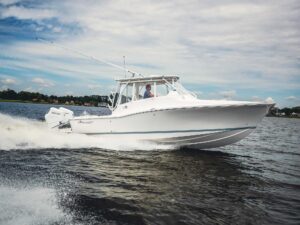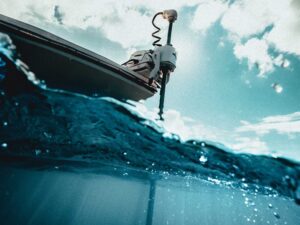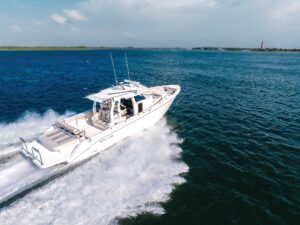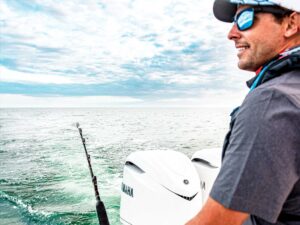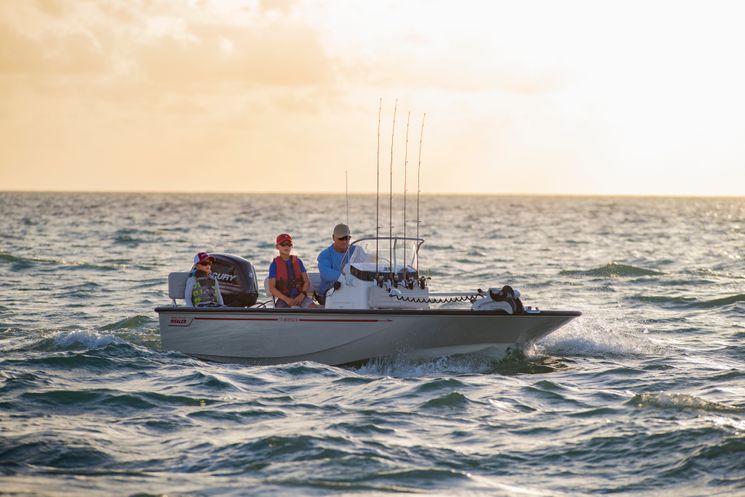
What is the minimum size boat for offshore fishing? The answer depends on who you ask. The challenge and your budget are the two biggest reasons for fishing from a small offshore boat. Many cite the unique satisfaction of taking on the ocean to fish it on their own terms, knowing they have the boat, the knowledge and the ability to get out there, catch some good fish and get back.
“There’s definitely the excitement of being out there in a small boat where you’re in control and doing your own thing,” said Angelo Cuanang, a West Coast offshore fishing writer and expert who regularly fishes off San Francisco Bay. He’s done so for many years — all in a 17-foot Boston Whaler Montauk. Being unsinkable, the Whaler is one of the best small boats for ocean fishing.
One school of thought from skilled mariners actually considers a smaller hull advantageous in large swells. Tom King, once a professional mate in Massachusetts, for years made the 20-plus-mile run to fish Stellwagen Bank aboard his 19-foot Midland (“a Nova Scotia-style hull,” he said, with a very high bow and very low freeboard). “We came home riding on top of the big seas like an eggshell, while much bigger sport-fishing boats were having a tough time rolling in the swells.”
For purposes of this discussion, let’s focus on saltwater fishing boats with a minimum size ranging from 17 to 22 feet in length overall (LOA). A boat this size has an element of responsiveness that much larger hulls lose. In addition to being a criterion for offshore fishing, this size range also offers the best small boats for rough seas. Of course, rough seas are relative, and distance from shore often dictates the decision to go or not go.
– GET A VHF RADIO –
Safety Tip Provided by the U.S. Coast Guard
A VHF marine band radio is your first line of communication on the water, allowing you to talk to the Coast Guard and other boat traffic. Use Channel 16 only for hailing and emergencies.
Offshore Boating Benefits of Small Fishing Boats
Besides the challenge, downsized boats are less expensive and easy to tow on the road than king-size boats. Small boats can also be easier to handle and dock in tight quarters, though features such as joystick controls on larger boats are making low-speed maneuvers easier for skippers of large boats.
Start comparing costs of purchase, insurance, moorage or storage, maintenance and so on for a 30-foot center-console with those of a 22-footer. Then of course there are fuel costs. At today’s prices, a day fishing a 30-footer with twin 300 hp outboards can cost you in the high hundreds of dollars, if not more than $1,000. But you can run offshore and troll all day in a boat such as the Robalo R222 (21 feet 6 inches LOA) or Sea Chaser 22 HFC (21 feet 9 inches LOA) with a single 200 or 250 hp outboard for a few hundred or less.
Lots of anglers trailer their boats 50 to 100 miles at the drop of a hat. Compare hauling a double- or triple-axle trailer behind a ¾- to 1-ton pickup versus a lighter, single- or double-axle trailer behind a half-ton pickup — and there’s even more economy.
Small-Boat Knowledge, Ability and Common Sense
There’s no federal regulation stating that “Thou shalt not take thy boat and go (offshore),” and in fact the Coast Guard only has authority in a few places to prevent boaters from going where they want, a Coast Guard spokesman said. To go or not to go is not the question. Rather, focus on knowing your small boat, recognizing when to go or not, and with what gear and preparation.
Accident reports often retell scenarios where anglers in small boats perished before the Coast Guard could reach them. Often these are cases where knowing the boat and having the right equipment could have saved lives. Experience often makes a major difference when it comes to safety. Anglers who know what the ocean can dish out and respect that power choose to err on the side of caution, and do not scrimp on safety gear.
Many who skipper such mighty mites far from land tend to be independent by nature. Still, many make it a point to travel offshore with another boat — known as “buddy boating”— when possible, small or large, which in effect offers a second engine.
Whether or not you have a buddy going with you, be sure to file a float plan before you leave. That can be as simple as making sure someone back on land knows when you plan to depart and return, and where — in general — you expect to fish.
– LOWER YOUR RATES –
Safety Tip Provided by the U.S. Coast Guard
Taking a boating safety course won’t just make you a better skipper. It could also help you save big on insurance.
The Right Boat: Moderate Vees and Hard Chines
What is the best small boat for offshore fishing? There are plenty of 17- to 22-footers for fishing bays, channels or flats. But if you plan to run offshore, you’ll need to investigate construction, quality and design.
That said, some bay boats such as the Pathfinder 2200 TE (22 feet 2 inches LOA) or Sea Born FX22 Bay Sport (21 foot 9 inches LOA) offer offshore fishing capability, as well as the ability to sneak into shallow inshore waters.
Still, there can be no doubt that with the specialized demands of offshore fishing, not all small hulls are created equal. When it comes to hull design, opinions vary — suggesting competent small hulls might come in more than one style.
A modified V rather than the deep V common on larger center consoles ranks as the top choice among experts looking for the optimal small planing hull for big water. While the steeper deadrise angle of up to 26 degrees at the transom offers the softest ride through waves, an angle in the 17- to 20-degree range proves more stable. That way you still get some damping effect from the V but also get some benefit of lateral stability.
Fuel capacity becomes a serious consideration for any small boat heading offshore. On the minus side: Many small boats have built-in tanks and some provide space only for portables. On the plus side: Light boats with small outboards can go all day on amazingly little fuel. Once you pick a boat, know its range and always allow for at least a 15 percent reserve.
A small but important point: marine battery placement. Batteries should ride forward, beneath the console, rather than at the transom, where they can get wet and add unnecessary weight.
One other essential element of small boat construction that becomes particularly important offshore is flotation. Positive flotation is required for certification by the National Marine Manufacturers Association in boats less than 20 feet, but the best hulls are fully filled with foam, and the reasons should be obvious. In an emergency, water can force air out of a hull or sides but not out of foam. A light hull gains little weight (always a factor) but considerable strength and rigidity from foam.
Water In, Water Out
A small boat easily takes on spray and, on rough days, some green water as well. That’s when scuppers become critical. (This assumes that no angler without a death wish would be offshore in a boat that’s not self-bailing.) The scuppers must be able to drain water as fast as it comes into the hull — if not, you’ll soon be playing submarine.
Transom height and design also play key roles in keeping water out of small boats. A small outboard-powered boat faces trouble fast once enough ocean water enters and runs to one side or the other in heavy seas. To help avoid that, look for small offshore boats with a full transom. A cut-out transom might work with a really good, generous motorwell. Worst case for offshore: a low, cut-out transom with no well. If that describes your boat, stick to the bay.
The Right Offshore Boating Equipment
No small boat, however seaworthy and stable, belongs offshore — ever — if it’s not properly equipped. The most major piece of equipment to consider is your outboard engine. A traditional preference among blue-water anglers has been twin or even triple outboards for safety. However, adding a second engine for the small boater might be either cost-, design- or weight-prohibitive. Fortunately, today’s outboard engines are more reliable than ever.
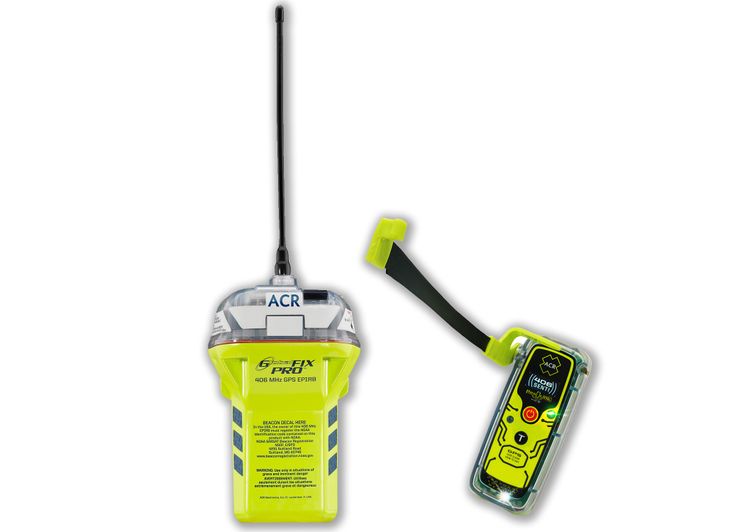
When feasible, a small auxiliary engine (aka kicker) is a great addition since it can get you home in a pinch — but, again, it may not be worth the additional weight on the stern of a 17- to 22-footer.
Additional key safety equipment to carry when fishing offshore includes the following:
Fixed-Mount VHF Radio — Fundamental and essential. Fixed-mount radios offer a range of 15 to 20 miles while handhelds only reach out 3 to 8 miles. All new VHFs, by law, come with Digital Selective Calling, which instantly sends a distress call to authorities anywhere in the world. Be sure that you set up your DSC calling feature before leaving port. Cell phones are popular everywhere, including offshore, and offer some backup. But these can’t substitute for a VHF in a pinch since users might not find coverage in all areas offshore, and a phone call does not immediately summon on-water help. Mate your VHF radio to a tall (8-foot) VHF antenna for the range necessary when fishing offshore.
GPS Plotter/Sounder — As critical for navigation as for fishing. Separate units are fine, but a single unit (capable of showing both chart plotter and sounder reading on screen simultaneously) maximizes limited space on small consoles.
Compass — With a good nautical chart, a compass will keep you headed in the right direction if your GPS fails. Amazingly, some small boaters venture far offshore with neither radio nor compass, according to the Coast Guard.
Extra Battery — Any boat fishing offshore should have a dual-battery system with a selector switch. This allows you to keep one battery in reserve in case one goes dead.
Emergency Beacons — An EPIRB (Emergency Position Indicator Radio Beacon) and a PLB (Personal Locator Beacon) are good ideas for any boat fishing offshore. Once activated, an encoded digital message is received by satellites, and is then transmitted back to ground-based search and rescue authorities. This signal provides information to assist in the search. Assuming you have properly registered the EPIRB or PLB, it tells rescuers who you are, your boat type and size, where you are, and other important data, including emergency contact information. An EPIRB is registered to the boat and is usually mounted on deck, while a PLB is registered to an individual and is carried by that person.
Life Jackets — Going offshore without them would not only be illegal but insane. Make sure your jackets are Coast Guard rated for offshore use (Type I). It is a good idea to wear a life jacket at all times, especially if fishing alone.
Emergency Kit — including flare gun and flares, cyalume sticks and waterproof strobe lights. (I also make sure my boat’s running lights are in good working order.) Don’t forget a good flashlight and extra sunscreen.
Emergency Food and Water — At least a half-gallon of water, some granola bars and beef jerky or canned meat can get you through a day or two.
Anchor and Lots of Line — Even if you don’t anchor to fish, you might find an anchor valuable, and plenty of heavy line is a must if you need to be towed.
Sea Anchor — Space might preclude stowing a small sea anchor, but make sure you have at least a bucket or, in a pinch, even a spare life jacket. Most boats tend to drift stern-to — the worst situation in a building sea. Your odds of staying afloat when broken down and adrift go up by a big chunk if you can keep the bow into the waves, and any sort of sea anchor will help accomplish this.
– CARRY A BEACON –
Safety Tip Provided by the U.S. Coast Guard
Satellite beacons such as EPIRBs or PLBs allow boaters to transmit distress signals and their exact coordinates from anywhere on the planet, no cell service required. It may be the best $400 you ever spend.
Pick the Right Fishing Weather
Given a seaworthy boat, properly equipped, everything else comes down to common sense. And nowhere can the small boater better demonstrate that than by reading the weather before and during a trip.
Starting out the morning in a 3-foot sea is a mere irritant to a 30-footer, but for the mini-boater who has his head screwed on right, it means a canceled trip. Many mornings I’ve arisen to find the weather service data revised from the previous evening’s 5- to 10-knot wind forecast to one of 10 to 20 knots. Anyone hoping to go offshore in a 17- to 22-footer has to realize his fishing days will be limited.
Look for periods between frontal systems, particularly in fall, winter and spring when dead-calm days sneak in between blows. During the summer, high pressure systems often bring many successive days of calm weather, particularly in the morning. The run home in many regions might mean a moderate but manageable chop, thanks to afternoon sea breezes.
Just be sure you know the marine forecast for the day, before you head out. When the forecast calls for light breezes all day and into the night, boating anglers with small boats can usually venture forth into offshore ocean waters with peace of mind. Otherwise, the best rule of thumb is a simple one: When in doubt, don’t go out.

